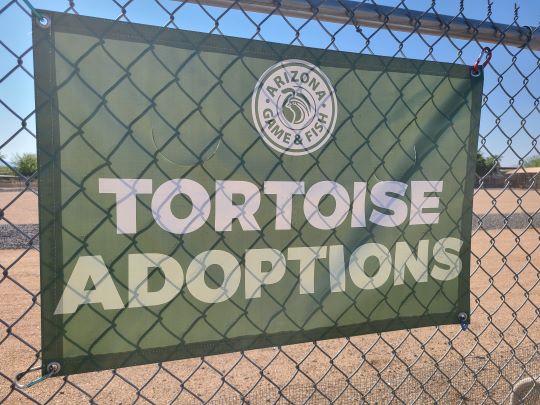“There are quite a few rattlesnakes in the area, so please stay in your vehicle and text me when you arrive.” This message from Tegan Wolf, Desert Tortoise Adoption Program Coordinator for Arizona Game and Fish Department, was likely meant as a warning. But, for us, it was an enticement.
We were meeting with Tegan to see about volunteer opportunities for the new Wildlife Center at the Game and Fish location, hoping to work with reptiles. Learning that rattlesnakes occupied a lot of space here only served to confirm that we were in the right place. We are always on the lookout for snakes!
Training
To begin our volunteer service, we would be working in the tortoise adoption pens, raking, picking up tortoise droppings, counting individuals to determine any escapes or deaths, and removing old food and delivering fresh. As many as 10 baby tortoises can occupy one large enclosure. “Some mortality in the hatchlings is normal,” said Tegan. “Not all the babies survive.” Adult enclosures usually house no more than one tortoise. “It is super rare for them to get along no matter gender,” says Tegan, “plus we don’t want breeding.”
According to Tegan, the adoption facility exists to place unwanted or surrendered homeless tortoises with people who are willing to build proper enclosures and provide long-term care for an animal that could outlive them. All the tortoises are captive bred.
Tegan explained and demonstrated the duties we would perform, and it was obvious how much she cared for the tortoises. “I’ve been doing this for 10 years,” she replied when I asked. She not only knew the names of each, she also related their personalities.
And we definitely noticed that they have personalities! A couple days after our training, as we began cleaning enclosures with the young tortoises, several of the babies ambled over and began examining my boots and nibbling on the shoestrings. Their curiosity was evident. In the adult enclosures, several emerged from their burrows to greet or inspect the new arrivals scooping up debris from their surroundings. Some followed us as we worked.
Adopting
Most people who want to adopt a tortoise, according to Tegan, are looking for an adult. They are not usually interested in hatchlings. Anyone adopting a tortoise or two would need to build a well-insulated burrow. Their yard would need to be enclosed and preferably have a grassy area available for the animal. The captive tortoises are given grass, hay, and limited produce such as romaine lettuce and occasional watermelon. If someone wants to adopt more than one tortoise, Tegan is happy to let them try the same gender together. “But they have to be very vigilant,” she says, “and they need to be aware that if they aren’t, one of the tortoises could end up in a fatality.” And the tortoise would need to be returned if the adopters leave the state.
As we finished our training with Tegan, we made arrangements to come on a weekly basis to help out. We are looking forward to working with the welcoming staff at Game and Fish, as well as these personable animals! But we have yet to see a rattlesnake…






This new gig sounds like it was tailor made for you two! So much interesting information about tortoises and what they are doing there. Great pic, Betty, with your tortoise,
Yep, the beat goes on! Always something else to learn. Thanks for your comments!
Loved this and I appreciate both of you at the center. You two make a great team and addition to ours! I’m glad you are enjoying yourselves. ❤️
Thanks, Nichole! We enjoy and learn from your crew and admire their passion in wildlife care!
So glad to see you all back at it. Looks like fun.
Still looking for the promised rattlesnakes but the facility is run by some very supportive and passionate folks. Enjoying the ride!
Enjoy your new adventure!
It’s a fantastic opportunity for us and the Desert Tortoises. They are a pleasure to work with and so’s the Game and Fish folks!
My grandchildren and I had a rather scary and rare experience a couple of weeks ago. A whole bunch of Eastern brown snakes were mating (or perhaps fighting?) on the path right outside the house. We had a really great vantage point from my granddaughter’s bed, through her window. The snakes were biting at each other and seeing their open mouths so close up was awful – it was the stuff of nightmares. A snake man came to attempt to remove them, but was unable to do so. He said there were too many heads and bodies for him to be able to get at. I was so worried he was going to be bitten! We just had to wait until they finished and moved off, but I was scared to go outside, especially to walk on that path for several days. Eastern Browns are the world’s 2nd most deadly, and responsible for the majority of snake bite deaths in Australia. Although they broke up their orgy and moved away, they are obviously still in the vicinity and their offspring will be arriving soon.
Caroline, thanks for you comments. Australia has the largest diversity of venomous snakes in the world, including some of the top of the list as most venomous. It’s nice to know our blog is being read in NSW!